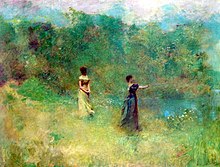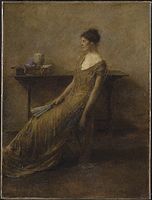Thomas Dewing
Thomas Dewing | |
|---|---|
Boston, Massachusetts | |
| Died | November 5, 1938 (aged 87) |
| Nationality | American |
| Education | Académie Julian, Paris |
| Known for | Painting |
| Movement | Tonalism |
| Spouse | Maria Oakey Dewing |
| Patron(s) | John Gellatly, Charles Lang Freer |


Thomas Wilmer Dewing (May 4, 1851 – November 5, 1938) was an American painter working at the turn of the 20th century. Schooled in Paris, Dewing was noted for his figure paintings of aristocratic women. He was a founding member of the Ten American Painters and taught at the Art Students League of New York. The Freer Gallery of Art at the Smithsonian Institution has a collection of his works.[1] He was the husband of fellow artist Maria Oakey Dewing.
Personal life and education
Thomas was born in
In 1880 he moved to New York where he met and married Maria Oakey Dewing,[4] an accomplished painter with extensive formal art training[5][6] and familial links with the art world.[citation needed] They had a son who died while an infant. In 1885 their daughter Elizabeth was born.[5] The Dewings spent their summers at the Cornish Art Colony in New Hampshire from 1885 to 1905.[7] These years may not have been as peaceful as they seemed, however. Thomas lost both of his surviving siblings, Paul F. and Louise within a month of each other in 1903.[8][9]
Career
Upon his return to the United States from France in 1878,[3] Dewing returned to Boston.[4] The following year he painted Morning, a composition of two women dressed in Renaissance gowns, which is said by biographer Ross C. Anderson to have the quality of Pre-Raphaelite paintings and emotion of a James McNeill Whistler work.[3] He began teaching at the Art Students League of New York in 1881, the same year he married Maria Oakley.[3]
He is best known for his tonalist paintings, a genre of American art that was rooted in English Aestheticism. Dewing's preferred vehicle of artistic expression is the refined, aristocratic female figure[3] situated in a moody and dreamlike surrounding.[10] Often seated playing instruments, writing letters, or simply communicating with one another, Dewing's sensitively portrayed figures have a detachment from the viewer that keeps the spectator a remote witness to the scene rather than a participant.[citation needed]
He was elected into the National Academy of Design in 1888.[11] Dewing was a founding member of the Ten American Painters in 1898, a group of artists who seceded from the Society of American Artists in 1897.[3][12] He joined the Society of Landscape Painters, founded in 1899, where he was more aligned with other Tonalist artists.[12] Among his awards were medals at the Paris Exhibition (1889), at Chicago (1893), at Buffalo (1901) and at St Louis (1904).[13]
Key collectors of his works were John Gellatly and Charles Lang Freer.[4]
Later years
He did not paint much after 1920 and lived out his later years in his Cornish, New Hampshire, home.[3] His wife died in 1927 in New York City[7] and Dewing died in New York in 1938.[3]
Legacy
A noted Dewing scholar and curator is Susan A. Hobbs, who co-authored The Art of Thomas Wilmer Dewing: Beauty Reconfigured and co-curated a 1996 exhibition of his works of the same name with Dr. Barbara Dayer Gallati. Until that time it was the largest retrospective of his works; 70 paintings—oils, watercolors, silverpoints and pastels—were shown at the
- Selected artwork
-
The White Dress
-
Woman in Black: Portrait of Maria Oakey Dewing, oil on panel, 1887
-
Lady in Gold, 1912, Brooklyn Museum
Collections
His works are in private collections and museums in the United States. At the Freer Gallery of the Smithsonian Institution, a room is devoted to Dewing's paintings.[4]
References
- ^ "Thomas Wilmer Dewing - Explore and Learn - Freer and Sackler Galleries". Archived from the original on 7 October 2017. Retrieved 6 December 2019.
- ^ "United States Census, 1870," database with images, FamilySearch(https://familysearch.org/ark:/61903/1:1:MD35-SR2 : 12 April 2016), Sophronia Dewing, Massachusetts, United States; citing p. 121, family 839, NARA microfilm publication M593 (Washington D.C.: National Archives and Records Administration, n.d.); FHL microfilm 552,144.
- ^ ISBN 978-0-19-533579-8. Retrieved 28 January 2012.
- ^ a b c d e f The Art of Thomas Wilmer Dewing. Brooklyn Museum of Art. Retrieved February 15, 2014.
- ^ ISBN 978-1-4381-0791-2. p. 54.
- ^ "Hood Museum of Art Acquires Rare Outdoor Still Life by Maria Oakey Dewing". Traditional Fine Arts Organization, Inc. 2010. Retrieved 2012-01-28.
- ^ a b "Search Artists / American Art". Smithsonian Institution. Retrieved 2012-01-28.
- ^ "Massachusetts Deaths, 1841-1915," database with images, FamilySearch(https://familysearch.org/ark:/61903/1:1:NWX1-CFN : 11 March 2018), Louise Dewing, 08 Apr 1903; citing Cambridge, Massachusetts, v 540 cn 497, State Archives, Boston; FHL microfilm 2,057,764.
- ^ "Massachusetts Deaths, 1841-1915," database with images, FamilySearch(https://familysearch.org/ark:/61903/1:1:NWDR-J8F : 11 March 2018), Paul F. Dewing, 14 Mar 1903; citing Boston, Massachusetts, v 541 cn 2420, State Archives, Boston; FHL microfilm 2,057,764.
- ^ "Thomas Wilmer Dewing - oi".
{{cite journal}}: Cite journal requires|journal=(help) - ^ National Academians: Surname beginning with "D". Archived 2014-01-16 at the Wayback Machine National Academy of Design. Retrieved February 15, 2014.
- ^ a b Erik Brockett, "The Ten American Painters," Antiques & Fine Art Magazine. Retrieved February 15, 2014.
- ^ Chisholm, Hugh, ed. (1911). . Encyclopædia Britannica. Vol. 8 (11th ed.). Cambridge University Press. p. 139.



